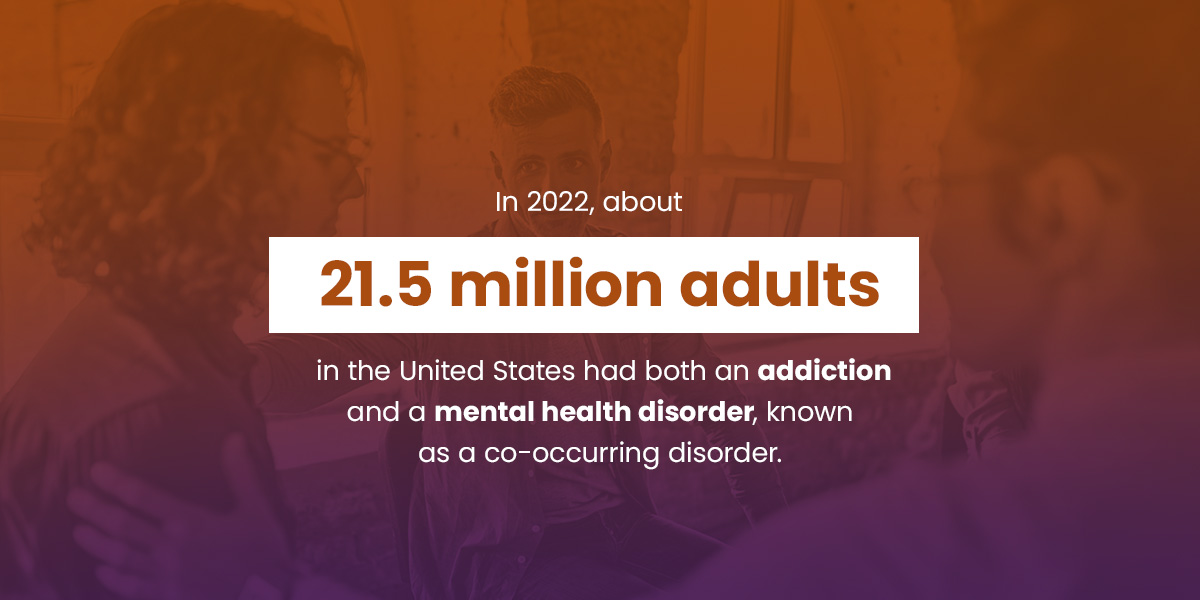Substance use disorders (SUDs) take a major toll on a person, contributing to various physical, mental and emotional conditions. According to data from 2022, 2.2 million individuals in America regularly use cocaine, with 1.5 million meeting the criteria for an addiction.
If you suspect that your friend, partner or family member is struggling with an SUD, it can be a heartbreaking experience. Being able to spot the signs your loved one is addicted to cocaine is the first step to finding the proper treatment and facilitating a successful recovery.
Below, we’ll explain what to look for and what you can do to help them get the care they need.
Learn About Our Cocaine Addiction Program
Understanding Cocaine Addiction
Before exploring the signs of a cocaine addiction, it can be helpful to understand what an SUD is. Rather than a choice or moral failing, addiction is a recognized medical condition that changes the brain. This perspective can help you separate the person you love from their use of cocaine, reducing stigma and allowing for more empathetic support.
Derived from coca leaves, cocaine is an illicit drug with a high chance of addiction. It can be snorted, smoked or injected. The method used changes the length of the drug’s stimulating effects. For example, smoking cocaine creates a faster high, but it lasts much shorter compared to snorting it.
When individuals use cocaine, they experience a surge of dopamine in the brain, which is the chemical responsible for pleasure. The drug also blocks the removal of dopamine from the brain. The feeling of pleasure drives individuals to continue using the substance.
How Cocaine Affects the Body and Mind
Cocaine causes damage to the body and mind over multiple uses. Repeated use also causes physical and psychological dependence, which results in a cocaine use disorder (CUD). Let’s look at this drug’s short-term and long-term effects.
Short-Term Effects
Many of the short-term effects of cocaine use result from the stimulating properties of the substance, which include:
- Elevated heart rate
- Increased blood pressure
- Upset stomach
- Headaches
- Anxiety or paranoia
- Vertigo
- Tremors or involuntary movements
- Hyperactivity and insomnia
Long-Term Effects
Prolonged cocaine use can damage the body in multiple ways. These effects impact areas such as:
- The cardiovascular system: Long-term cocaine use can cause an irregular heartbeat, blood clots, clogged arteries and high blood pressure. People who use cocaine for a long time also experience a higher risk of a heart attack.
- The gastrointestinal system: Many people are unaware of the effect cocaine can have on the gastrointestinal system. This includes constipation, nausea, vomiting and abdominal pain. Since cocaine is a stimulant, it also decreases appetite, resulting in weight loss.
- The respiratory system: If a person snorts or smokes cocaine, it directly affects the respiratory system. Some of the effects include shortness of breath, coughing, coughing up blood, swelling in the lungs or infection. People who have preexisting respiratory conditions, such as asthma, will aggravate these by using cocaine. The symptoms of their condition may worsen, and additional problems can also develop.
- The central nervous system: Long periods of cocaine use can seriously affect the brain. It damages the brain structure and reduces its ability to produce serotonin and dopamine on its own. Long-term use can also result in hallucinations and psychosis.
Cocaine use can also affect one’s mental well-being. People with conditions like depression and anxiety will sometimes use substances to cope with stress and other symptoms of mental illnesses. While substance use may provide temporary relief, these conditions usually worsen.
How to Tell if Someone Is Using Cocaine
People with SUDs often have clear indicators of addiction. However, some signs of cocaine use are more subtle and can be easy to overlook. This can delay essential treatment and increase the risk of harm.
Being able to recognize a CUD in your loved one is vital for seeking help and empowering them to regain control over their lives. Early intervention can also prevent some of the damaging long-term effects.
Here are some of the physical, emotional and behavioral signs that could indicate your friend, partner or family member is using cocaine.
Physical Signs
Physical changes are often the most noticeable signs of addiction. If your loved one is using cocaine, they might start to neglect their regular self-care routines. For example, they may stop showering or doing their laundry. Additionally, those facing an SUD often lose interest in maintaining their appearance, exercising or participating in other physical activities.
Due to the drug’s stimulating effects, weight loss is common. Someone who uses cocaine will struggle to keep up with their regular diet, as their appetite is suppressed. Many people with SUDs experience malnutrition.
Stimulants also increase an individual’s alertness, making them appear restless. These effects are linked to disrupted sleep patterns and symptoms of insomnia. While a lack of sleep can cause various problems throughout the body, one of the most visible issues is dark circles under the eyes.
Other telltale physical signs of a CUD include:
- Regular nosebleeds.
- Changes in skin color.
- Sores on the face.
- Dilated pupils.
- Dental problems, such as decaying gums or teeth.
- White powder around the nose or mouth.
- Track marks at the injection site, often on the inner arm, hands or feet.
Emotional Signs
People who use cocaine often exhibit emotional signs. For example, a CUD can result in erratic behavior and violent outbursts due to the drug’s ability to impair decision-making and reduce one’s inhibitions.
Extreme irritability and a depressed mood are also common, especially as the effects of the drug wear off. You might notice that your loved one experiences severe mood swings. Their energy levels may shift abruptly between high and low, and they may appear alert despite not sleeping.
Some people with a CUD may be attempting to self-medicate their mental health conditions but end up making their symptoms worse over time. Those with conditions like anxiety and bipolar disorder also have a higher risk of developing an addiction. In 2022, about 21.5 million adults in the United States had both an addiction and a mental health disorder, known as a co-occurring disorder.

Cocaine use can also cause individuals to experience:
- Suicidal thoughts
- Paranoia
- Hallucinations
Behavioral Signs
Changes in behavior are another common sign of addiction. Many people with a CUD devote most of their time to seeking and using cocaine, causing them to struggle with multiple aspects of their lives. For example, your loved one may have lost interest in their old hobbies or activities.
They may also find it challenging to perform as expected at work or school, possibly failing to show up for their commitments. Sometimes, people begin using cocaine to help their performance, but it often has the opposite effect and can lead to addiction. They may be distracted by thoughts of using or might be experiencing uncomfortable side effects of long-term use.
Cocaine and relationships do not mix. Your loved one may lie or hide things from you and other friends or family members, covering up their addiction out of shame or fear of judgment. Often, they’ll neglect their relationships and withdraw or stop contacting loved ones altogether. The individual also might not maintain their responsibilities, such as helping out around the home or paying their bills. The tension created as a result can cause them to continue using cocaine as a way to cope.
Lastly, cocaine can also cause criminal or financial trouble. Some people commit crimes to get money for drugs. Others may be involved in violence due to their drug use since a CUD can increase irritability and aggression. A person may also spend excessive money to get cocaine, especially since it is one of the most expensive street drugs. This can lead to debt, and the additional stress can increase the risk of drug use.
How to Help Someone With a Cocaine Addiction
If a loved one is struggling with an addiction, here’s what you can do to get them to stop using cocaine:
1. Talk to Them
The first step is to talk to the person about their cocaine addiction. Some people may have attempted to quit but have been unable to stop. Or, they might not see that a problem exists.
Approach the conversation with understanding and compassion rather than judgment. Even if you’re upset about their use, your objective is to encourage change — not to start an argument.
To help them consider treatment, ask questions like, “How has your use affected you lately?” or “Are you open to getting professional support?”
2. Stage an Intervention
If they refuse treatment, an intervention may be necessary. You don’t have to wait until your loved one has reached the proverbial rock bottom. Instead, the sooner, the better — their rock bottom could be a severe injury or prison.
An intervention can happen at any stage of addiction and is generally a meeting between friends, family members and other loved ones, planned without the knowledge of the addicted individual. Since some people cannot readily admit they have a problem, the unexpected nature of an intervention helps them confront their CUD without being given a chance to avoid the meeting.
The goal of an intervention is to motivate your loved one to seek treatment when they need it. If you’re worried that they might react aggressively or if they’re prone to violent outbursts, get professional support. Addiction experts can help guide you through the process to avoid a reactive confrontation.
As you prepare, have everyone write down instances where the individual’s cocaine addiction has harmed their relationship. Be careful to only use “I” statements so the intervention doesn’t come off as aggressive or confrontational. Offering your continued support is key, but state clear consequences that will happen if your loved one doesn’t seek help, and don’t hesitate to follow through if necessary.
3. Arrange Treatment
If everything goes according to plan, your loved one should feel motivated to start treatment. It’s a good idea to set up treatment options ahead of time, so contact a facility or other professionals. This way, your loved one can get the care they need once the intervention has ended. Arranging their treatment can also prevent any additional stress that might hinder them from starting their recovery journey.
When choosing a treatment facility, remember that many offer medication-assisted treatment, but not all address the underlying issues contributing to cocaine addiction. A holistic approach focuses on a person’s well-being rather than just their condition, encouraging recovery and preventing relapse-related fear. It aims to look at the person as a whole, including their physical, mental and emotional needs. Holistic treatment for cocaine addiction seeks to empower individuals and show them that they can make positive changes in their lives.
Additionally, the use of traditional 12-step programs also focuses on the idea that addiction is a lifelong disease prone to relapse. Our brains can heal from the effects of cocaine, and holistic treatments can help people with addiction create new neural pathways. They’ll learn how to reconnect with themselves and create healthy habits that make using cocaine undesirable, allowing them to live a life of wellness. Some of the modalities include:
- Meditation
- Yoga
- Supplements
- Mental activities
- Organic nutrition
Once this healing is complete, your loved one will no longer be consumed by thoughts of cocaine or experience fear of relapse. Having rebalanced their mind, body, spirit and soul, they’ll emerge as the best versions of themselves.
4. Be Prepared for Withdrawals
It’s important to understand that recovery isn’t a quick fix — the early stages are often the most challenging. Someone who stops using cocaine will experience various withdrawal symptoms, affecting them physically and psychologically. While the physical symptoms will typically resolve in a few days, the psychological symptoms can last for months.
The severity of cocaine withdrawal symptoms depends on the amount used during the period of use. Some common withdrawal symptoms include:
- Exhaustion and fatigue: Cocaine keeps you awake and alert while in your system. However, once the body detoxifies, a person might experience intense exhaustion or fatigue.
- Anhedonia: This is a symptom where an individual is unable to feel pleasure. Detoxing impacts their ability to produce serotonin and dopamine.
- Concentration issues: Cocaine muddles the hormones in the brain, and a person going through detox might have trouble focusing or thinking clearly as a result.
- Depression and anxiety: Withdrawal from cocaine can alter a person’s mood as the hormones in their body fluctuate and rebalance, causing depression and anxiety.
- Cravings: When a person stops using a substance, they’ll experience cravings, which are urges to use it again. Cravings can also appear after exposure to triggers, which are things or situations that influence someone to use a substance.
- Body aches and pain: Pain is a common withdrawal symptom because cocaine can impact the body’s ability to produce endorphins. Without these natural painkillers, a person might experience more aches and pains. Tremors and chills caused by withdrawal can also contribute to body pain.
- Increased appetite: The stimulating effects of cocaine suppress the appetite during use. Once the drug leaves the body and detox begins, a person will likely start eating more and begin to gain back the weight they had lost.
- Nightmares or other sleep disturbances: Some withdrawal symptoms, such as depression and anxiety, can contribute to sleep disturbances. The stress from the withdrawal can also cause additional problems during the night.
Withdrawals from cocaine don’t typically require medical intervention, despite the uncomfortable feelings they may cause. However, there are tools to manage these symptoms and make recovery more comfortable for your loved one. Whether in an outpatient or inpatient program, it is paramount to let them know they are supported through this process. Overcoming the physical withdrawal symptoms is a significant step toward recovery.
Tips for Helping Someone With a Cocaine Addiction
When helping your loved one overcome their cocaine addiction, it’s important to:
- Educate yourself: It’s essential to have a clear understanding of what cocaine is doing to your loved one. Do further research on how substance use affects the body, mind and personal relationships, and come equipped with this knowledge when you start a conversation.
- Analyze the root cause: A person will have triggers that cause cravings, such as trauma, mental health conditions and stress. Analyze the factors in your loved one’s life to determine what could be contributing to their cocaine addiction. Addressing these can help your loved one understand their addiction and motivate them to take the necessary steps to get help.
- Be patient yet persistent: Some individuals struggle with admitting to their addiction, and they may experience relapses or setbacks. Be patient and understanding, but don’t give up. Continue being persistent about getting your loved one help.
- Offer your support: Your loved one should feel like they can rely on you for help and that you aren’t judging or shaming them for their addiction.
- Set boundaries: Make it clear that you don’t support their cocaine use and implement the necessary boundaries to make this evident. For example, you can refuse to let them use cocaine in your home or withhold money you know they’ll spend on it.


